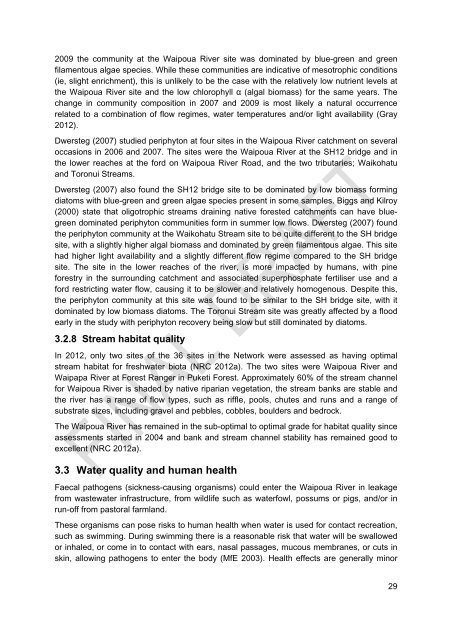Waipoua River 20130219.pdf - Northland Regional Council
Waipoua River 20130219.pdf - Northland Regional Council
Waipoua River 20130219.pdf - Northland Regional Council
- No tags were found...
Create successful ePaper yourself
Turn your PDF publications into a flip-book with our unique Google optimized e-Paper software.
2009 the community at the <strong>Waipoua</strong> <strong>River</strong> site was dominated by blue-green and greenfilamentous algae species. While these communities are indicative of mesotrophic conditions(ie, slight enrichment), this is unlikely to be the case with the relatively low nutrient levels atthe <strong>Waipoua</strong> <strong>River</strong> site and the low chlorophyll α (algal biomass) for the same years. Thechange in community composition in 2007 and 2009 is most likely a natural occurrencerelated to a combination of flow regimes, water temperatures and/or light availability (Gray2012).Dwersteg (2007) studied periphyton at four sites in the <strong>Waipoua</strong> <strong>River</strong> catchment on severaloccasions in 2006 and 2007. The sites were the <strong>Waipoua</strong> <strong>River</strong> at the SH12 bridge and inthe lower reaches at the ford on <strong>Waipoua</strong> <strong>River</strong> Road, and the two tributaries; Waikohatuand Toronui Streams.Dwersteg (2007) also found the SH12 bridge site to be dominated by low biomass formingdiatoms with blue-green and green algae species present in some samples. Biggs and Kilroy(2000) state that oligotrophic streams draining native forested catchments can have bluegreendominated periphyton communities form in summer low flows. Dwersteg (2007) foundthe periphyton community at the Waikohatu Stream site to be quite different to the SH bridgesite, with a slightly higher algal biomass and dominated by green filamentous algae. This sitehad higher light availability and a slightly different flow regime compared to the SH bridgesite. The site in the lower reaches of the river, is more impacted by humans, with pineforestry in the surrounding catchment and associated superphosphate fertiliser use and aford restricting water flow, causing it to be slower and relatively homogenous. Despite this,the periphyton community at this site was found to be similar to the SH bridge site, with itdominated by low biomass diatoms. The Toronui Stream site was greatly affected by a floodearly in the study with periphyton recovery being slow but still dominated by diatoms.3.2.8 Stream habitat qualityIn 2012, only two sites of the 36 sites in the Network were assessed as having optimalstream habitat for freshwater biota (NRC 2012a). The two sites were <strong>Waipoua</strong> <strong>River</strong> andWaipapa <strong>River</strong> at Forest Ranger in Puketi Forest. Approximately 60% of the stream channelfor <strong>Waipoua</strong> <strong>River</strong> is shaded by native riparian vegetation, the stream banks are stable andthe river has a range of flow types, such as riffle, pools, chutes and runs and a range ofsubstrate sizes, including gravel and pebbles, cobbles, boulders and bedrock.The <strong>Waipoua</strong> <strong>River</strong> has remained in the sub-optimal to optimal grade for habitat quality sinceassessments started in 2004 and bank and stream channel stability has remained good toexcellent (NRC 2012a).3.3 Water quality and human healthFaecal pathogens (sickness-causing organisms) could enter the <strong>Waipoua</strong> <strong>River</strong> in leakagefrom wastewater infrastructure, from wildlife such as waterfowl, possums or pigs, and/or inrun-off from pastoral farmland.These organisms can pose risks to human health when water is used for contact recreation,such as swimming. During swimming there is a reasonable risk that water will be swallowedor inhaled, or come in to contact with ears, nasal passages, mucous membranes, or cuts inskin, allowing pathogens to enter the body (MfE 2003). Health effects are generally minor29
















